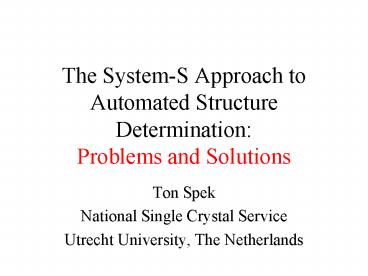The SystemS Approach to Automated Structure Determination: Problems and Solutions
1 / 27
Title:
The SystemS Approach to Automated Structure Determination: Problems and Solutions
Description:
Yes, in many cases given good quality low temperature reflection data and ... atom structures with no disorder and with no unknown solvent of crystallization. ... –
Number of Views:65
Avg rating:3.0/5.0
Title: The SystemS Approach to Automated Structure Determination: Problems and Solutions
1
The System-S Approach to Automated Structure
DeterminationProblems and Solutions
- Ton Spek
- National Single Crystal Service
- Utrecht University, The Netherlands
2
Is a Fully Automatic Structure Determination
Possible ?
- Yes, in many cases given good quality low
temperature reflection data and correct prior
knowledge of the chemical composition. - Good examples are light atom structures with no
disorder and with no unknown solvent of
crystallization. - No, in all cases needing an experienced
crystallographer (I.e. when no automated methods
are available yet for the problem at hand) - e.g. many/most coordination complexes.
3
Current Setup in Utrecht
- KappaCCD/Rotating Anode/LNT
- I
- Collect, DENZO or EVAL-CCD (Not AUTO!)
- I
- import.cif (includes Formula Unit Cell)
- I
- Silent System-S Auto-Mode platon -F import.cif
- I
- Result files -gt ORTEP/PLUTON Plots
4
Typical Import CIF Filter Job
- Unix Command Line Instruction
- platon F import.cif
- .. Wait 0.5 minute ..
- Standard Console Output
- Tentative Result on /mnt/spea/import_s.cif
- and /mnt/spea/import_s.
res - Validation Report /mnt/spea/import_s.chk
- Details may be found in /mnt/s/import
5
0.5 Min. from import.cif to ORTEP (3GHz Linux Box)
6
System-S Approach
- Crystallographic Shell around public domain tools
(SHELX, SIR, PLATON etc.) - Two Modes of operation
- Guided Mode Suggests/Executes next step in the
structure determination (handles I/O) - Automatic Mode (NQA-Mode) Executes automatically
all default steps - Build-in Structure Validation
- System-S is included in the UNIX PLATON exe.
7
Standard System-S Example
- Two files name.ins name.hkl
- Content name.hkl SHELX style HKLF 3/4
- Content name.ins TITL, CELL, CELLSD, SFAC, UNIT,
HKLF 4 (or 3) - Note No Spacegroup Info Needed
- Run s name.ins NQA.
- 18 Seconds later for C16H20NO3P .
8
(No Transcript)
9
Problems and Solutions
- There are still many interesting Real World
problems to be solved for a full proof automatic
replacement of an experienced crystallographer. - Already the use of the Guided Mode to quickly try
multiple approaches to solve a structure is a big
help (even for the experienced crystallographer) - System-S stores all relevant I/O files in a
hierarchic directory structure for inspection
when problems arise.
10
Problem 0 Complete Failure
- Example The chemist provides us with crystals
labeled to be a Zn-coordination complex requiring - human Expert Forensic Crystallography to
tell us that the inorganic salt MnK2(SO4)2 gives
us a perfect fit with the experimental data. - Partial Solution Check with databases (I.e.
CELL or simulated powder patterns) and stop.
11
Failure 1 Space group
- The space group can not always be determined
uniquely from systematic absences (e.g Cc or
C2/c). - Some structures solve only in lower than the
actual space group symmetry (sometimes only in
P1) - Solution loop over the various space group
candidates to solve the structure and use ADDSYM
to find out about the correct symmetry of the
model (implemented in S).
12
Failure 2 Phase Problem
- Attempts to automatically solve a structure with
a single solution package might fail. - Solution loop over all available packages and
approaches until a solution is found. - System-S SHELX86, SHELXS97, SHELXD, SIR97,
SIR2002, DIRDIF99 - Workup with EXOR Example next
13
Raw Output from SHELXS86
14
Result of the EXOR workup
15
Failure 3 Incorrect Atom Type Assignment
- Automatic atom type assignment is not always
straightforward. - A large variation in displacement parameters
often hampers a correct atom type assignment - Solution detailed analysis of intra- and
intermolecular geometry and ADPs - Example next
16
Misassigned Atom Types (S P)
17
Atom Type Assignment
- Assignment Methods (can be) based on
- 1 - An analysis of the Peak heights Shapes
- 2 - the value of the displacement parameters
- 3 - Population parameter refinement (S)
- 4 - Refinement of each site with alternative
- scattering types (E.g. C,N,O)
- 5 - Chemistry ( CSD knowledge, Mogul)
18
Failure 4 - Disorder
- Type 1 Orientational, Conformational or
Substitutional disorder of (part of) the
structure. - Solution (Expert) Crystallographer
- Type 2 Voids filled with unknown (mixtures of)
solvents. - Solution PLATON/SQUEEZE
19
Failure 5 - Twinning
- (Pseudo) Merohedral Twinning may lead to refined
structures with unexpectedly high final R-values
and high residual peaks in a difference Fourier
Map. - Solution Software to detect the applicable twin
law. - E.g. Rotax (Simon Parsons Bob Gould)
available in WINGX and CRYSTALS or - PLATON/TwinRotMat
- Example next .
20
3 independent molecules
Space group P-3 R 20
21
(No Transcript)
22
(No Transcript)
23
Problem 6 Wrong Structure
- Sometimes automatic procedures can come up with
reasonably looking but wrong structures. - Structure validation software should send out
proper ALERTS (e.g. IUCr Checkcif) - Example The chemist expects a Cu-complex, so
that is what he gets (confirmed by X-ray
crystallography !) . and tries to publish and
caught by a knowledgeable referee on the bases
of Checkcif ALERTS.
24
R lt 7
Cu not Coordinated gt
ORTEP of the False Structure
25
R lt 6
Ortep of the Correct Structure
26
CONCLUDING REMARKS
- SYSTEM-S can be used easily for the
re-examination of structures with CIF FCF data
taken from the Acta Cryst Archives or for
refereeing purposes to investigate unclear
details of the analysis. - Future implementation
- C,N,O etc. discrimination in difficult cases
- More chemical knowledge
- Extension of the already available procedures
for structure determination without any
Content Information.
27
End































